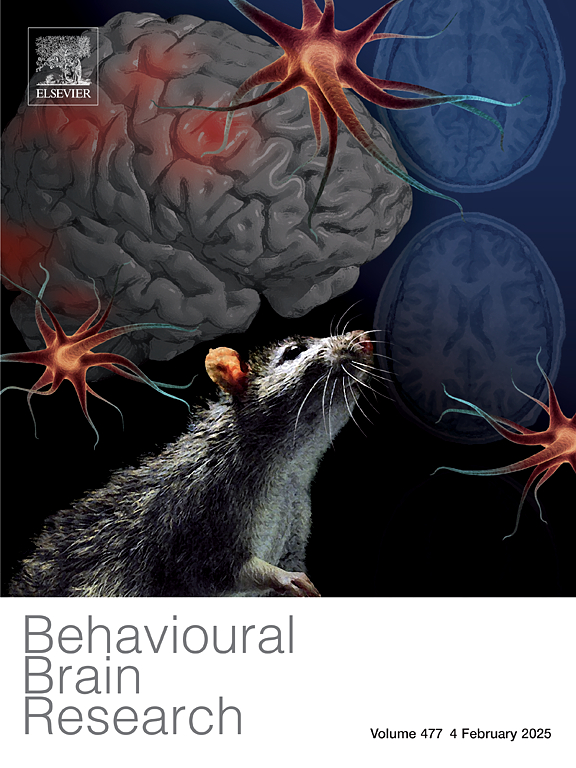研究帕金森病冷漠的结构神经影像学特征。
IF 2.3
3区 心理学
Q2 BEHAVIORAL SCIENCES
引用次数: 0
摘要
背景:冷漠是高达70%的帕金森病(PD)患者的常见症状,并且随着疾病的进展,它往往会恶化。它是PD患者不良临床结果和生活质量下降的独立预测因子。冷漠与较低的治疗依从性有关,并对照顾者的情感健康产生重大影响。确定pd相关冷漠的神经基础对于确定治疗靶点和预后生物标志物至关重要。目的:探讨PD患者相对于对照组冷漠的神经解剖学基础。方法:选取24例PD患者和25例对照组进行横断面研究。参与者接受了全面的临床评估和结构磁共振成像(MRI)方案。结合临床、人口学、体积和皮质厚度数据的弹性网回归模型用于确定两组冷漠量表(AS)评分的关键预测因子。结果:确定了AS评分的显著神经解剖学预测因子,PD患者和对照组具有明显的预测因子。PD组AS评分的最佳预测指标是右侧颞极皮质厚度,而对照组的最佳预测指标是胼胝体中前部体积。这些模型揭示了各组之间预测因子的强度和方向的差异。结论:该研究强调了PD中冷漠的独特神经解剖学相关性,为该疾病的潜在机制提供了见解。这有助于更广泛地了解pd相关的冷漠,并突出了治疗干预的潜在领域。本文章由计算机程序翻译,如有差异,请以英文原文为准。
Investigating the structural neuroimaging signature of apathy in Parkinson's disease
Background
Apathy is a common syndrome in up to 70 % of people with Parkinson's disease (PD), and it tends to worsen as the disease progresses. It is an independent predictor of poor clinical outcomes and reduced quality of life in PD patients. Apathy is linked to lower adherence to treatment and has a significant impact on the emotional well-being of caregivers. Identifying the neural basis of PD-related apathy is vital for determining treatment targets and prognostic biomarkers.
Objectives
To define the neuroanatomical basis of apathy in PD compared to controls.
Methods
Cross-sectional study including 24 patients with PD and 25 controls. Participants underwent a comprehensive clinical assessment and a structural magnetic resonance imaging (MRI) protocol. Elastic Net regression models with clinical, demographic, volumetric, and cortical thickness data were used to identify key predictors of the apathy scale (AS) scores in both groups.
Results
Significant neuroanatomical predictors of the AS scores were identified, with distinct predictors for PD patients and controls. The best predictor of AS scores in the PD group was the cortical thickness of the right temporal pole, while the best predictor in the control group was the volume of the mid-anterior corpus callosum. The models revealed differences in the predictors' strength and direction between groups.
Conclusions
The study underscores the distinct neuroanatomical correlates of apathy in PD, offering insights into the condition's underlying mechanisms. This contributes to the broader understanding of PD-related apathy and highlights potential areas for therapeutic intervention.
求助全文
通过发布文献求助,成功后即可免费获取论文全文。
去求助
来源期刊

Behavioural Brain Research
医学-行为科学
CiteScore
5.60
自引率
0.00%
发文量
383
审稿时长
61 days
期刊介绍:
Behavioural Brain Research is an international, interdisciplinary journal dedicated to the publication of articles in the field of behavioural neuroscience, broadly defined. Contributions from the entire range of disciplines that comprise the neurosciences, behavioural sciences or cognitive sciences are appropriate, as long as the goal is to delineate the neural mechanisms underlying behaviour. Thus, studies may range from neurophysiological, neuroanatomical, neurochemical or neuropharmacological analysis of brain-behaviour relations, including the use of molecular genetic or behavioural genetic approaches, to studies that involve the use of brain imaging techniques, to neuroethological studies. Reports of original research, of major methodological advances, or of novel conceptual approaches are all encouraged. The journal will also consider critical reviews on selected topics.
 求助内容:
求助内容: 应助结果提醒方式:
应助结果提醒方式:


